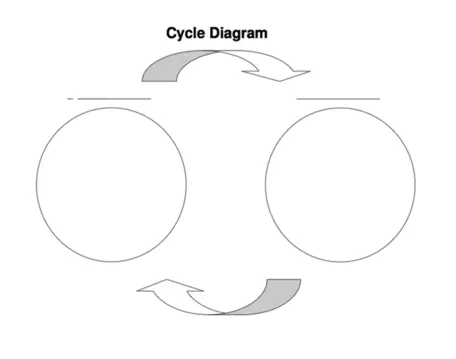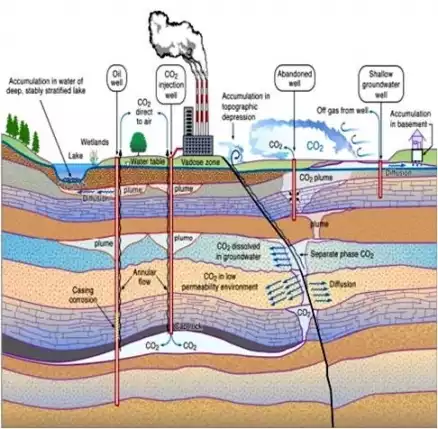Activity: Learning to Play by Nature’s Rules - Eco Tipping Points
Summary
This lesson teaches students how to recognize vicious and virtuous cycles, and then uses a news article about Hurricane Katrina to learn how to diagram the cyclical relationship between ecosystems and social systems. They will differentiate between approaches to water control taken in the United States and new policies developed in Holland called 'making room for water.' This lesson is suitable for any level of high school social studies, and is particularly suitable in the context of Geography, U.S. History, and Government courses.
Learning Goals
Context for Use
Description and Teaching Materials
Suggested Procedure:
- Introduce the idea of cycles to students. Most students recognize the example of a vicious cycle that can develop when a frustrated mother is with a cranky toddler. Asking students what happens if the toddler starts to fuss, cry, scream, usually leads to description of an escalating vicious cycle in which both parties become more upset and upsetting. A virtuous cycle is likewise easily understood by asking student what happens in a relationship when people extend each other warmth and trust. Once students understand the concept of a cycle, use the cycle diagram (below) to diagram another cycle they can identify.
- Give students the diagram Human Ecology (below), and use the key (below) to have them label the social systems and ecosystems and fill in the key elements of social and ecosystems.
- Give students a brief description of the devastation experienced during Hurricane Katrina. Pass out a copy of the Diagram 'The Politics of Levees' (below), and walk through the cycle that occurred between the social and ecosystems during the crisis of Hurricane Katrina. Students can draw a line connecting each action and reaction. This front-loading activity will help them understand the news article they read in the next step.
- Pass out the news article "Learning to Play by Nature's Rules" (below) and a copy of the Diagram "Two Approaches to Water Control" (below). After reading the article, students should use the top of the diagram to map out four actions and reactions in the vicious cycle that took place in New Orleans, and the bottom half to map out four actions and reactions that take place in the virtuous cycle of making room for water in Holland.
- An extended activity would be to go online to research how water control policies have evolved in these two places since Hurricane Katrina.
Materials
Below you can find the following documents for use with this lesson:
- Cycle Diagram
- Human Ecology Diagram
- Human Ecology Key
- The Politics of Levees
- Learning to Play by Nature's Rules
- Two Approaches to Water Control
- Two Approaches to Water Control Key







Teaching Notes and Tips
An EcoTipping Point is a lever that reverses environmental decline, setting in motion restoration and sustainability. EcoTipping Points do this by transforming the feedback loops (vicious cycles) responsible for environmental decline into virtuous cycles that power restoration.
Feedback loops are the key to how EcoTipping Points work. EcoTipping Points set in motion a cascade of effects that reverse the vicious cycles responsible for environmental decline. The vicious cycles are transformed into "virtuous cycles" that propel the eco-social system toward sustainability. The ensuing proliferation of positive effects creates additional virtuous cycles that "lock in" the benefits. Environmental success stories point to the key ingredients that make it all happen.
EcoTipping Points are typically an environmental technology (in the broadest sense), coupled with the social organization to put it into effective use. They are catalytic. EcoTipping Points set in motion a cascade of far-reaching effects through the system.
However, far-reaching effects are not enough. The environmental success stories that we've analyzed tell us that the crucial action for both problems and solutions resides in feedback loops, circular chains of cause and effect that amplify small causes into large effects.
Feedback loops explain why vicious cycles are so hard to break. But they also expose the strategic points at which the cycles can be reversed. Like Aikido, the martial art that turns an attacker's thrusts back on the attacker, EcoTipping Points can identify critical maneuvers for reversing the currents of ecological destruction. Instead of continuing to wear the system down, the same forces begin to build it back up.
Environmental decline can be turned around if the vicious cycles responsible for decline are reversed. EcoTipping Points connect to vicious cycles with the force necessary to do that. Once reversed, the vicious cycles become "virtuous cycles", driving positive change with the same power that drove the negative change. In effect, the virtuous cycles mobilize natural, social, and economic forces to work for sustainability instead of against it.
EcoTipping Points transform the feedback loops (vicious cycles) responsible for environmental decline into virtuous cycles that power restoration.
The EcoTipping Points Project:
A New Hope for Positive Change and Sustainability
EcoTipping Points are levers for restoring sustainability to our imperiled environment – small actions that tip the balance from decline to restoration by tapping the inborn power of nature and human societies to heal themselves.
Many environmental and social problems are so complex and overwhelming it's hard to know where to begin. But pioneering communities around the world are showing what it takes to succeed.
As we assemble their stories, the scientific goal of the EcoTipping Points Project is to better understand what made them successful. The pragmatic goal is to help people identify "tipping point" levers right at home – concrete actions that they and their community can act upon. The EcoTipping Points Project is dedicated to making the stories and their lessons known through the media, workshops, and direct collaboration with community groups.
EcoTipping Points are real - In every success story, the sweeping changes from environmental decline to restoration and sustainability can be traced back to a lever that set the change in motion. That lever is the EcoTipping Point – typically an environmental technology (in the broadest sense of the word) combined with the social organization to put the technology into practice. The lever is catalytic, setting in motion a cascade of changes through ecosystem and social system. But it takes more than that to be an EcoTipping Point – which leads to our next finding.
Reversal of vicious cycles - In all of our stories, the decline was driven by interconnected and mutually reinforcing vicious cycles. Decline was turned around only when the vicious cycles driving decline were themselves turned around. Anything less is merely "swimming against the current." Reversing the vicious cycles is seldom easy; they can be very powerful. But it's the only way to change to a course of restoration. Here is the good news - once the vicious cycles are turned around, the very same feedback loops can mobilize nature and natural social processes to work just as powerfully to bring about restoration and health. And they spin off new virtuous cycles, such as "success-breeds-success", which accelerate the process and lock in the gains.
Ingredients for Success - What does it take to turn around the vicious cycles driving decline? What makes an effective EcoTipping Point lever? What are key characteristics of the eco-technology – and the social organization for putting that eco-technology into practice? We have found eleven things to play a strong role in our stories. They all contribute to making a "positive tip" really happen. Most or all them may in fact be essential.
References and Resources
Citation
Duffy, D. (2012). Activity: Learning to Play by Nature's Rules - Eco Tipping Points. Retrieved from http://www.camelclimatechange.org/view/assignment/51cbf3b17896bb431f6adc2e


![[creative commons]](/images/creativecommons_16.png)